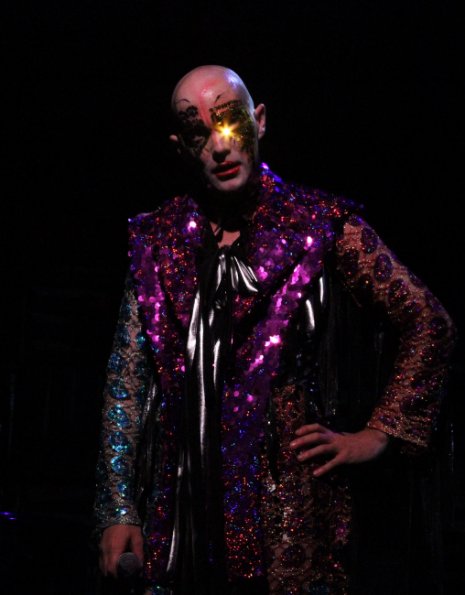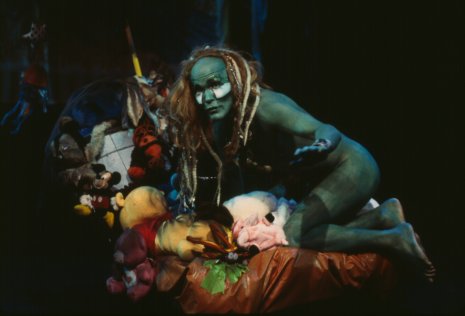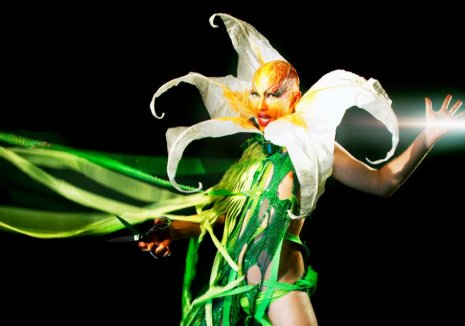Background
What follows is the email conversation between Taylor Mac and Morgan Jenness, creative director, This Distracted Globe Consultancy, dramaturge, and Herb Alpert Award panelist, March-April 2015.
Morgan Jenness:
Can we talk a bit about your trajectory? I remember first encountering you when you were performing Orpheus at HERE – a moment I will never forget. (I know you had an interesting history before that, and, of course, have had since…) What were some significant pivot points, markers along the road of where you began, leading to where you are now? It seems that you don't really repeat yourself much, that each one of your experiences, whether writing or performing, opens up another portal, another layer to what you are exploring. Is this deliberate or circumstantial or perhaps a bit of both?
Taylor Mac:
I started off as an actor, training at the only school I could afford that accepted me, the American Academy of Dramatic Arts in New York. There I studied Method, Meisner, and a little Commedia, Shakespeare, and the Greeks. It was a great foundation and though it doesn’t have the kind of clout that gets your foot in any doors (other than the door of technique), I did learn how to learn and graduated with little debt (something that’s kept my overhead down over the years and eased the financial burden a theater artist’s salary gives you.) The best part of the school was being in New York and having access to free tickets. I worked early in the morning, went to school in the afternoon, and would go to the theater at night. Pretty much every single night, for about four years, I’d be at the theater with free Broadway, Off-Broadway, Off-Off tickets. I’d usually go to everything at least twice, regardless of whether I liked it or not. The show I saw more than any other – roughly forty times - was Bill Irwin and David Shiner’s “Fool Moon.” I was fascinated with Shiner’s audience participation work. I learned how improvisation was a little bit of off-the-cuff creation and a lot about building a Rolodex of possibilities, depending on audience reaction. Essentially it was about putting in the hours of performance and developing a personal craft.
I think that experiencing all the variety of work at that time opened me up to playwriting. In 1996, upon graduating, I started writing my first play,“The Hot Month.” I organized a reading of it, with the help of Tracy Trevett, a director/friend/mentor/collaborator I’d met at the Academy. The reading was a great success and encouraged my further writing. This company Circle East, a remnant from the Circle Repertory Lab, was open to doing a reading of a play of mine, and Michael Warren Powell, their artistic director, sat down with me, for free, and went through every line to talk about the beats. It was essentially my first playwriting class. I applied for a fellowship with the Ensemble Studio Theater to further develop “The Hot Month,” got it, and Romulus Linney, as my mentor, did the same thing Michael had. I started writing more plays and having more readings and fell in love with the craft of playwriting. Even though the plays were always a little off-kilter (often non-linear, tons of overlapping dialogue, and plays that could not be turned into movies), they still were formulaically and aesthetically following a fairly normative lineage.
During this time I auditioned for an Off-Broadway musical that had been running for about a year. They were replacing the lead actor (who had also written the musical). I got a couple callbacks and they asked me if I knew what I was auditioning for. I said no; I wasn’t in school any more so had to buy my tickets and couldn’t afford it. They got me a ticket, I went to the show, and when it was over I sat in the theater sobbing because the possibility that I could do what the writer/performer on the stage was doing felt like discovering a calling. The writer/performer was John Cameron Mitchell and the show, of course, was “Hedwig and the Angry Inch.”
Years later I made a performance art concert about lineage called “Comparison is Violence” where I talked about being embarrassed that “Hedwig” was the catalyst for my drag. I wasn’t embarrassed because of John’s material but because it took something that was a commercial success (even if it hadn’t been turned into a movie yet) to show me the part of my creative self I was missing. When I moved to New York a whole generation of my theatrical progenitors had just died or were dying from AIDS. I never got to meet or experience Ethyl Eichelberger or Charles Ludlum or Klaus Nomi, or Leigh Bowery or the great Harry Kondoleon. They weren’t there to pass the baton so it took me a little longer to find them and discover a lineage I could connect to. Luckily John Cameron Mitchell and a few others were there and had met and experienced those people. After another callback or two, they ended up giving the role to Michael Cerveris (who is now a friend and who I probably would have cast too).
Shortly after my “Hedwig” experience I met Brandon Olson and Jonny Woo. They were young drag performance artists who were in the tradition of Bowery, Eichelberger, and Jackie Curtis. They used drag as a tool to communicate radical ideas rather than identity politics, pure entertainment or assimilation. They were Fools and, for me, medicine. I needed a place to stay at the time and Brandon’s roommate, Blue Lips performer Lavinia Co-op, was living in London for six months and decided to sublet her NY room, which was essentially a drag closet. I moved in. The rule was I wasn’t allowed to use Lavinia’s drag but one night a tower of costumes fell on me, while I slept, and it was too much to resist.
I started going out to the clubs and performing five-minute performance art numbers wherever I could. (The club world has fewer rules than the theater world so if you want to perform, you usually just have to show up with something interesting.) I met and became part of a community of performance artists -- muses like James Tigger! Fergusson, Justin Vivian Bond and Kenny Mellman, The World Famous *Bob*, Karen Finley, drag mama and icon Mother Flawless Sabrina and, of course, Penny Arcade -- and through bouncing off their work and spirits my understanding of what I wanted to do as an artist and how I wanted to do it started to come into focus. Essentially my form and aesthetic became tied to the content which was tied to a much more radical understanding of heterogeneity.
I began making fuller length performance art works and putting in the hours of performance necessary to build a personal craft. My show, “The Face of Liberalism,” was the first full-length performance art play I created and I ran it once a week for six-months in a basement bar on the Bowery. Some nights I’d have four people in the audience and some, a maximum of seventy. I started bringing theater into the clubs and the clubs into the theater. Kristin Marting, at the Here Arts Center saw me perform a version of “The Face of Liberalism” at her theater for the Dixon Place/Here Arts Center Fuse Festival and I became a resident artist at Here. Liz Swados ended up mentoring me and recommended me for the Peter S. Reed grant, which ended up financing the making of my play, “The Young Ladies Of.” PS 122 gave me their Ethyl Eichelberger award, which was $4,000 to write and produce a show (luckily everyone in it was loving enough to work for stipends).
Up until that point all the performance art plays I’d written were solo works but I missed writing ensemble plays and wanted to create something for the new community I found myself in, so I wrote my first ensemble musical, “Red Tide Blooming.” Nina Mankin became my muse wrangler (her term that I wholly agree with and love as a description for her). She essentially agreed to dramaturge so much of the work during this time and, like Michael, Romulus, and Liz before her, went through all the beats with me. Nina also introduced me to you, Morgan, and I was able to add yet another mentor/major influence to my life. A year later the producer/manager Paul Lucas saw me and brought me to Edinburgh, where my show, “The Be(A)st of Taylor Mac” got enough attention that we were able to tour it internationally. I learned what it means to have a long run. We did roughly two hundred performances of “The Be(A)st” in opera houses, basement bars, tents, black boxes, factories, galleries, art centers, museums, cabaret rooms, and even regular old theaters.
Between touring gigs I started working on my play, “The Lily’s Revenge,” and in 2009, after four years of development and raising money for this five-hour, thirty-six ensemble member extravaganza, the Here Arts Center co-produced the play with me. It turned out, because of its multi-genre form, eclectic cast, and heterogeneous aesthetic, to be the culmination of my theater and club training. It was also the high-water mark of my “emerging” work and inspired me to sink my teeth into two new durational pieces: “A 24-Decade History of Popular Music,” (a 24-hour performance art concert we’ve been developing for three years and that we’ll be performing in 2016), and four plays I’m working on about American polarization that will premiere separately but ultimately be performed in rep and in an all-day festival format. The first play, “Hir,” made its premiere at the Magic Theater in San Francisco and will make its NYC premier at Playwright’s Horizons in the fall of 2015.





